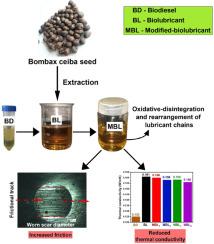蚕豆生物柴油诱导绿色润滑油的自氧化转化及其摩擦热后果
Q1 Chemical Engineering
引用次数: 0
摘要
随着人们对可持续润滑油的需求不断增加,棉铃虫生物柴油(BD)已成为开发低粘度、环保生物润滑油的一种有前景的添加剂。在本研究中,通过将提取的粗棉铃虫生物润滑剂(BL)与不同体积的BD(5、10、15和20 mL)混合制成改性生物润滑剂(MBL)配方。采用ATR-IR、1H NMR和GC-MS等技术分析了BL、BD和MBL的化学结构和组成。使用四球摩擦测试仪和KD2 Pro热性能分析仪评估摩擦磨损和传热性能。结果表明:添加BD促进了BL内部自氧化反应的分子重排,导致摩擦热性能下降;MBL1−MBL4的COF分别增加了19.76%、46.40%、36.48%和30.94%,导热系数分别下降了0.62%、1.86%、1.86%和3.10%。值得注意的是,含有超过5ml BD的混合物会经历过度的氧化分解,从而降低关键的润滑成分并损害摩擦学稳定性。总的来说,Bombax ceiba生物柴油展示了作为低粘度绿色润滑油的可持续添加剂的潜力,只要它在适当的混合限制下进行优化,并以商业标准为基准。本文章由计算机程序翻译,如有差异,请以英文原文为准。

Autoxidative transformation of green lubricants induced by bombax ceiba biodiesel and its tribo-thermal consequences
With the increasing demand for sustainable lubricants, Bombax ceiba biodiesel (BD) has become a promising additive for developing low-viscosity, eco-friendly biolubricants. In this study, modified biolubricant (MBL) formulations were created by blending the extracted raw Bombax ceiba biolubricants (BL) with different volumes of BD (5, 10, 15, and 20 mL). The chemical structures and compositions of BL, BD, and MBL were analyzed using ATR-IR, 1H NMR, and GC–MS techniques. The tribological and heat transfer properties were assessed with a four-ball tribotester and KD2 Pro thermal property analyzer. Results showed that adding BD promoted molecular rearrangement within BL through autoxidation reactions, which caused a decline in tribo-thermal performance. Specifically, COF increased by 19.76 %, 46.40 %, 36.48 %, and 30.94 %, while thermal conductivity decreased by 0.62 %, 1.86 %, 1.86 %, and 3.10 % for MBL1−MBL4, respectively. Notably, blends containing more than 5 mL BD experienced excessive oxidative disintegration, which reduced key lubricating components and impaired tribological stability. Overall, Bombax ceiba biodiesel demonstrates potential as a sustainable additive for low-viscosity green lubricants, provided it is optimized within appropriate blending limits and benchmarked against commercial standards.
求助全文
通过发布文献求助,成功后即可免费获取论文全文。
去求助
来源期刊

International Journal of Thermofluids
Engineering-Mechanical Engineering
CiteScore
10.10
自引率
0.00%
发文量
111
审稿时长
66 days
 求助内容:
求助内容: 应助结果提醒方式:
应助结果提醒方式:


